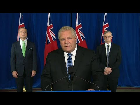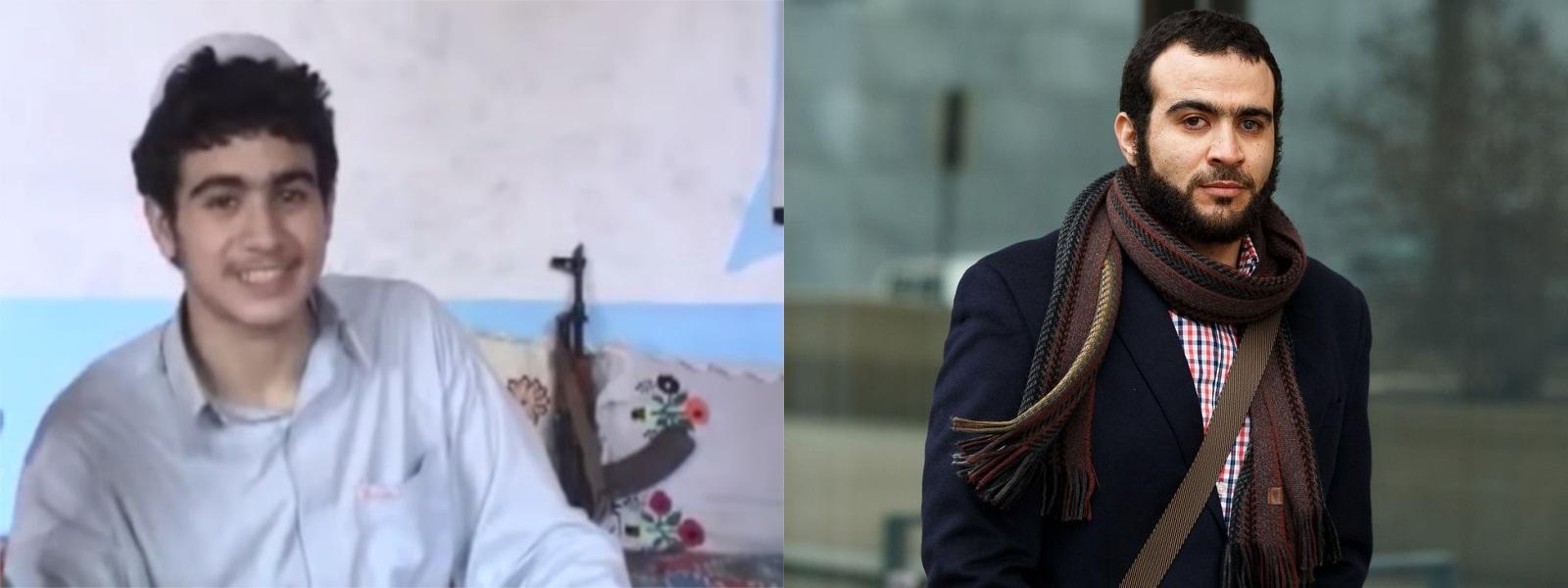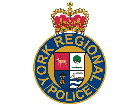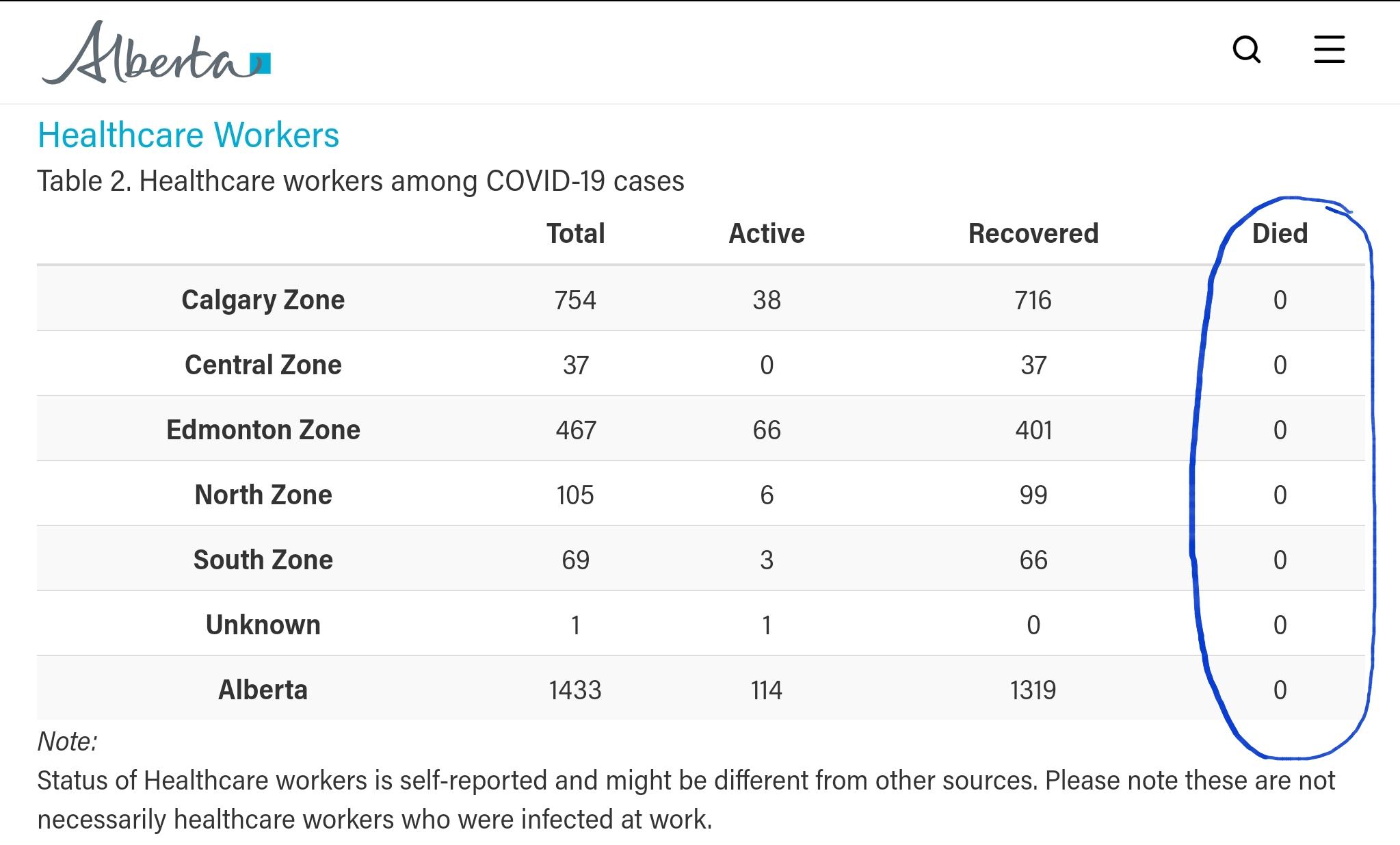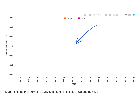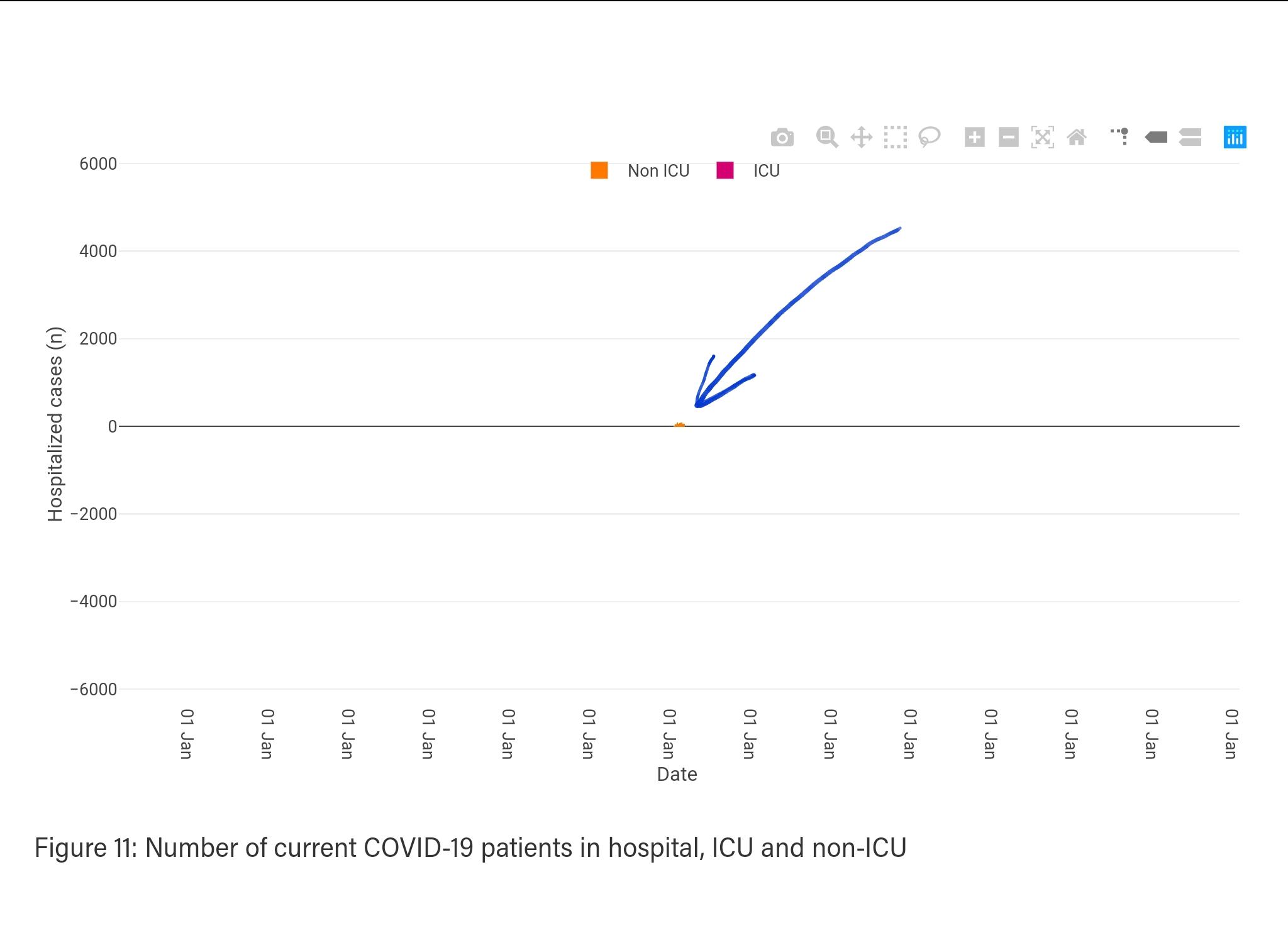Last available statistic year is 2018, when 26,037 Albertans died in just that year alone.
Alberta's population has increased since 2018, so our deaths per year would also increase. If we:
-
estimate that 28,000 people die in Alberta in 2020, and
-
estimate that deaths from/with the Wuhan Cough (currently 398 so far) will be at no more than 450 by the end of the year,
then we end up with 1.61% of all deaths in Alberta being people who died from/with the Wuhan Cough.
100(450/28000)=1.61%
Is that REALLY enough to justify destroying the future of our province and our country?
Link to survey: https://extranet.gov.ab.ca/opinio6/s?s=50964 It doesn't seem to ask where you're from or count how many times you submit, so I doubt they're going to use any of the input received. However it's worth a shot, and the survey is quick (text boxes are optional, you only have to tick boxes).
"I really hope for a level-headed outcome to all this, but I really have doubts that the UCP government will do anything useful for those who have been stolen from by decree.
"Imagine your hobby is slowly stolen from you, piece by piece, bit by bit, until you end up with something totally neutered and boring that you quit. Canadians used to be free, we used to be able to own pistols and converted automatics and all sorts of fun things, because we were a free people and we trusted our government as much as they trusted us. Then they took away automatics, and not enough people cared because they didn't feel they "needed" an automatic. Then they took away short barreled and small caliber pistols, and not enough people cared because they didn't feel they "needed" short barreled and small caliber pistols. Then they took away certain models of semi-automatics (the ones that resembled firearms from Hollywood films) as well as the rest of the pistols, and not enough people cared because they didn't feel they "needed" a cool-looking semi-auto or a pistol. Now they're here taking away big bores and even more semi-automatics, and not enough people will care because they don't feel they "need" a semi-automatic rifle or a 10 gauge shotgun. Sooner or later, despite how often these thieves try to tell you otherwise, they will be after shotguns and deer rifles: for the reasons that the shotguns are "destructive devices" and bolt-action centrefire rifles with scopes (almost all deer rifles) are "sniper rifles". It's much easier to fool someone than to convince them they've been fooled, and that's been the philosophy of Canadian governments ever since the seventies.
"Sure, we don't "need" any of those things. But nobody "needs" a mattress to sleep on. Nobody "needs" a car with leather seats. Nobody "needs" a boat. Nobody "needs" any of these things, but Canada is supposed to be a free country, and if an individual doesn't "need" something they should still be free enough to buy it (obviously excluding cases where the purchase of an object is directly correlated to causing harm, such as child pornography or other abhorrent material or human trafficking). The formerly-legal purchase of any of these prohibited firearms did not harm anyone, just like the purchase of a knife or a car doesn't harm anyone. It's only when the firearm (or knife or car) is misused or used to commit an offence should it be the state's concern.
"We're at a critical point in our country's and in our province's history: Do we scapegoat, bully, and demonize a small minority of innocent Canadians because they dare to keep what's legally theirs, or do we stand up for the freedoms of the people of Alberta and nullify the effect and prohibit enforcement of this disgusting decree?"
-
Canada didn't exist in 1752. It was King George the II of Great Britain that signed a treaty in 1752, not Canada.
-
Assuming that the treaty is valid, the eighth paragraph clearly states: "That all Disputes whatsoever that may happen to arise between the Indians now at Peace, and others His Majesty's Subjects in this Province shall be tryed in His Majesty's Courts of Civil Judicature, where the Indians shall have the same benefit, Advantages and Priviledges, as any others of His Majesty's Subjects." (emphasis added)
https://buyandsell.gc.ca/procurement-data/tender-notice/PW-ZL-105-38463
At the bottom there's a pdf with all the details with the amendment number of 000, either read it in English or Frog if you prefer.
Here are some of the important bits:
The purpose of this Request for Information (RFI) is to seek feedback from potential service providers in order to develop a strategy for the potential future management of these sites going forward. Should the Government of Canada determine that a third-party managed solution going forward is a viable strategy, Public Services and Procurement Canada (PSPC) may issue a Request for Proposal (RFP) to provide suppliers the opportunity to bid on the services required as per the schedule contained in this document.
Under the current Emergency Order in Council, all travellers arriving in Canada must have a suitable place to isolate or quarantine. Public Health Agency Canada (PHAC) is currently managing 11 designated quarantine sites (DQS) in 9 cities across Canada, with capacity to lodge up to 1600 travellers. PHAC regional staff are responsible for the management of 9 quarantine sites across Canada, with logistics, cleaning, transportation, food and nursing services provided by external providers. At this time, the DQS are being used to address the COVID-19 fourteen day quarantine requirements for international travellers not having a suitable place to isolate. Over time, the use of the DQS may be temporarily discontinued until needed again by the Government of Canada or may be used for other requirements. In anticipation of a possible continued need for quarantine sites over the next 1 to 2 years given the COVID 19 pandemic, PHAC is considering having a third party service provider provide and manage the existing sites and all of the related services on its behalf. PHAC may also consider expanding its site footprint to other locations provided in Annex C, attached.
The services managed by the third party service provider include: Lodging for up to 1600 people spread across Canada with the most frequent use and largest numbers at sites in Vancouver, Calgary, Toronto and Montreal. These could be hotels or other buildings where individuals, couples and /or families can be housed and provided the necessities of life. It will be important that the lodging be in close proximity to both the airport/port of entry and to an acute care hospital; Security services 24 x 7 at the sites by license guards which will be contracted separately; Infection Prevention and Control (IPC) Program that will maintain the integrity of the quarantine area. This includes: Controlled access to different areas + space for donning and doffing + separate entrance/exits with segregation of symptomatic and asymptomatic Travellers, Access to a trained IPC professional who can set up + train staff + and monitor IPC compliance at all sites, Provision of Personal Protective Equipment (PPE) to staff and Travellers in accordance with PHAC PPE guidance; Data collection and reporting including collection and maintenance of records of all Travellers lodged, including demographics, results of health assessments, health status, medication provision, mental health status, and total number of new and existing Travellers lodged and released by date and year to date total. Aggregate data on Traveller count difference from previous day as well as stratified by symptomatic status and reason for being lodged. Records to be stored and transmitted daily to PHAC in an encrypted and secure manner.
It is expected that use of the sites will increase or decrease as the need for the sites and services could vary over time. As a result, the service provider would need to be able to activate and resource a site and services with very short notice.
RFI Process (present stage): September - October 2020; RFP Release: December 2020; RFP Evaluations: February – March 2021; Contract Award: March 31, 2021
ANNEX B Current Designated Quarantine Sites: Calgary (nearby ports of entry Calgary Int'l, Edmonton Int'l, Coutts), Vancouver (Vancouver Int'l, Douglas Passenger, Pacific Highway, Huntingdon, Aldergrove, Vancouver Harbour Flight Centre), Kelowna (Osoyoos), Winnipeg (Winnipeg Int'l, Emerson), Regina (Regina Int'l), Toronto (Pearson Int'l and Billy Bishop City Airport), Montreal (Pierre Elliott Turdeau Int'l, St Bernard De Lacolle/Route 15, St.-Armand, Stanstead Route 55/Rock Island), Halifax (Halifax Int'l), Fredericton (St. Stephen, Edmundson, Woodstock, Fredericton), St John's (St John's NL), Whitehorse (Whitehorse)
ANNEX C Potential Future DQS Locations Near High Volume Ports of Entry: Saskatoon (Nearby port of entry Saskatoon), Windsor (Windsor, Ambassador Bridge, Blue Water Bridge, Windsor Tunnel), Niagara (Niagara, Fort Erie, Rainbow Bridge, Queenston Bridge), Ottawa (Ottawa Int'l, Lansdowne, Prescott), Sault Ste. Marie (Sault Ste. Marie), Winnipeg/Thunder Bay (Fort Frances, Pigeon River), Quebec City (Jean Lesage Int'l), Charlottetown (Charlottetown), Iqaluit (Iqaluit), Yellowknife (Yellowknife)
As you can see, the "LPC leak" was a few months off in terms of when these "Designated Quarantine Sites" predicted they be built. That calls into question the accuracy of the rest of their information. However, there are still reasons for concern with these sites, such as the stated ability for a site to rapidly deploy on short notice and the justification that these sites are necessary for "the next 1 to 2 years", as well as the "may be used for other requirements". If these places are going to be built or set up to prevent people from leaving, what then makes it any different than a low-security prison?



